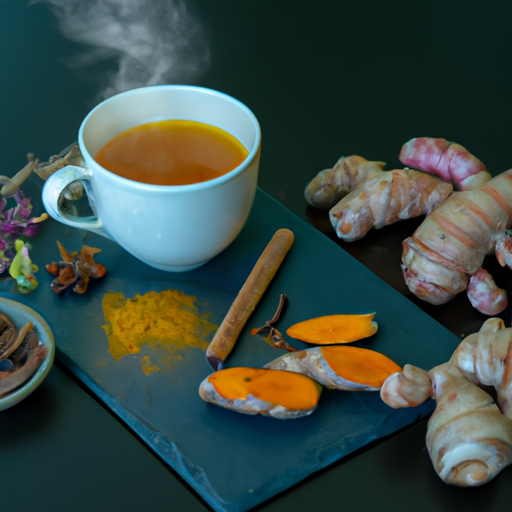Are you looking for a natural way to boost your health and wellness? Look no further than turmeric tea. This golden elixir has been used for centuries in traditional medicine for its numerous health benefits. But what is the best way to drink turmeric tea to make the most of its healing properties? In this article, I will guide you through the best practices for enjoying this miracle drink.
First, let’s dive into the health benefits of turmeric tea. From reducing inflammation to boosting immune function, this potent spice has a wide range of benefits that can improve your overall well-being. But to reap these rewards, it is crucial to choose the right turmeric tea product. I will provide you with tips on selecting the best quality tea to maximize its effectiveness.
Next, we will explore the proper preparation of turmeric tea. From brewing techniques to ideal steeping times, I will share the secrets to making a perfect cup of tea. Additionally, I will suggest some additions to enhance the taste and health benefits of your turmeric tea.
Incorporating turmeric tea into your daily routine is key to experiencing its full potential. I will discuss different ways to enjoy this tea, whether it’s sipping it in the morning or incorporating it into your favorite recipes.
However, it is important to be aware of potential side effects and precautions when consuming turmeric tea. I will provide you with the necessary information to ensure a safe and enjoyable tea-drinking experience.
Lastly, if you’re feeling adventurous, I will introduce you to some creative ways to use turmeric beyond just drinking tea. From face masks to smoothies, this versatile spice can be incorporated into various aspects of your life.
So, get ready to harness the power of turmeric tea and unlock a world of health benefits. Let’s dive into the best way to drink turmeric tea and optimize your well-being.
Key Takeaways
- Consuming turmeric tea with black pepper or fat enhances the absorption of curcumin, the active compound providing health benefits.
- Choosing high-quality ingredients and organic turmeric is important for maximizing the benefits of turmeric tea.
- Turmeric tea can be brewed using different methods such as traditional boiling, golden milk, or cold brew, each with its own unique flavors and health benefits.
- Adding ingredients like fresh lemon juice, black pepper, ginger, cinnamon, and honey can enhance the taste and health benefits of turmeric tea.
Understand the Health Benefits of Turmeric Tea
If you’re looking for a delicious and convenient way to boost your health, turmeric tea is the answer! Understanding the health benefits of turmeric tea is essential to fully appreciate its potential.
One of the key factors to consider is the curcumin bioavailability. Curcumin is the active compound in turmeric that provides many of its health benefits. However, it has low bioavailability, meaning that it’s poorly absorbed by the body. Consuming turmeric with black pepper or fat can significantly enhance curcumin absorption. Turmeric tea can be a great way to incorporate these ingredients and increase the bioavailability of curcumin.
Another benefit of turmeric tea is its potential for weight loss. Studies have shown that curcumin can help reduce body weight and improve metabolism. It can also suppress the growth of fat tissues and reduce inflammation, both of which are important factors in weight management. By incorporating turmeric tea into your daily routine, you can potentially support your weight loss efforts.
Now that you understand the health benefits of turmeric tea, it’s time to choose the right turmeric tea product.
Choose the Right Turmeric Tea Product
To get the most out of your turmeric tea experience, you’ll want to ensure you select the appropriate turmeric tea product. There are various turmeric tea brands available in the market, each offering their unique blend of flavors and health benefits. Some popular brands include Traditional Medicinals, Yogi Tea, and Numi Organic Tea. It’s important to read the labels and choose a brand that uses high-quality ingredients and organic turmeric.
Additionally, you can also create your own turmeric tea recipes at home. This allows you to customize the flavors and tailor the tea to your specific taste preferences. Some common ingredients to include in homemade turmeric tea recipes are ginger, black pepper, cinnamon, and honey. These ingredients not only enhance the taste but also provide additional health benefits.
To help you make an informed decision, here is a table comparing the three mentioned turmeric tea brands:
| Brand | Ingredients | Organic | Flavor Profile |
|---|---|---|---|
| Traditional Medicinals | Organic turmeric, spices | Yes | Earthy, Spicy |
| Yogi Tea | Organic turmeric, spices | Yes | Warm, Spiced |
| Numi Organic Tea | Organic turmeric, ginger | Yes | Bold, Zesty |
By choosing the right turmeric tea product, you can ensure a delightful and nourishing tea experience. In the next section, we will discuss how to prepare turmeric tea properly, so you can enjoy all its benefits.
Prepare Turmeric Tea Properly
When preparing turmeric tea, there are a few key points to keep in mind. First, use a brewing method that allows the turmeric to steep in hot water for maximum flavor and health benefits. It’s best to avoid boiling water as it can destroy some of the beneficial compounds in turmeric. Second, make sure the water temperature is hot but not boiling. Lastly, adding other ingredients like ginger, lemon, or honey can enhance the flavor and provide additional health benefits.
Brewing methods
For the best brewing results, I recommend steeping your turmeric tea with hot water and a squeeze of lemon juice to enhance the flavors. The hot water helps to extract the beneficial compounds from the turmeric, while the lemon juice adds a refreshing citrus note.
To explore alternative brewing methods and turmeric tea recipes, consider the following table:
| Brewing Method | Ingredients | Instructions |
|---|---|---|
| Traditional Method | Turmeric powder, water, ginger, black pepper | Boil the water, add the turmeric powder, ginger, and black pepper, and let it simmer for about 10 minutes. Strain and serve. |
| Golden Milk Method | Turmeric root, milk, honey, cinnamon | Grate the turmeric root and heat it with milk, honey, and cinnamon in a saucepan. Simmer for 10 minutes, strain, and enjoy. |
| Cold Brew Method | Turmeric powder, water, honey, lemon | Mix the turmeric powder, water, honey, and lemon in a jar. Refrigerate overnight, strain, and serve over ice. |
By experimenting with different brewing methods, you can find the one that suits your taste preferences. In the next section, we will delve into the optimal water temperature and steeping time for turmeric tea.
Water temperature and steeping time
The temperature of the water and the length of time you steep your turmeric tea can greatly impact its flavor and medicinal qualities. When brewing turmeric tea, it’s important to use hot water, but not boiling. Water that’s too hot can result in a bitter taste and can also destroy some of the beneficial compounds in turmeric.
A water temperature of around 195°F (90°C) is ideal for steeping turmeric tea. As for the steeping time, it’s recommended to let the tea steep for about 10-15 minutes. This allows the turmeric to fully infuse into the water, maximizing its flavor and health benefits.
After steeping, you can move on to the next step of adding other ingredients for enhanced flavor.
Adding other ingredients for enhanced flavor
To really elevate the taste of your turmeric tea, you can add a variety of ingredients that’ll enhance its flavor. There are countless turmeric tea recipes out there that incorporate different flavors and spices to complement the earthy taste of turmeric.
One popular option is to add a squeeze of fresh lemon juice, which not only adds a refreshing tang but also helps to increase the absorption of curcumin, the active compound in turmeric. Another great addition is a pinch of black pepper, as it’s been shown to enhance the bioavailability of curcumin.
Additionally, you can experiment with adding ginger, cinnamon, or honey to create a unique and delicious flavor profile. These additions not only enhance the taste but also contribute to the health benefits of turmeric tea.
By incorporating these ingredients, you can enhance the taste and benefits of your turmeric tea, making it even more enjoyable and nourishing.
Enhance the Taste and Benefits with Additions
When it comes to enhancing the taste and benefits of turmeric tea, I’ve found that adding ginger, lemon, or honey adds a delightful flavor to the drink. Not only does it make the tea more enjoyable to drink, but these additions also bring their own health benefits.
Additionally, I’ve learned that adding a pinch of black pepper to the tea can significantly enhance the absorption of curcumin, the active compound in turmeric.
Lastly, I’ve enjoyed experimenting with different spices and herbs such as cinnamon, cardamom, or mint to further elevate the taste and health benefits of my turmeric tea.
Ginger, lemon, or honey for added flavor
Adding ginger, lemon, or honey to turmeric tea really enhances the flavor and provides additional health benefits. Ginger has been used for centuries for its medicinal properties and has anti-inflammatory effects that can complement the benefits of turmeric. It can also help relieve digestive issues and improve immune function. Lemon, on the other hand, is rich in vitamin C and can provide relief from cold and flu symptoms. It also adds a refreshing citrusy taste to the tea. Honey is known for its soothing properties and can help soothe a sore throat and suppress coughs.
To give you a clearer picture, here is a table summarizing the health benefits of adding ginger, lemon, or honey to turmeric tea:
| Additions | Health Benefits |
|---|---|
| Ginger | – Anti-inflammatory effects |
| – Digestive support | |
| – Immune boosting | |
| Lemon | – Cold and flu relief |
| – Vitamin C boost | |
| – Refreshing taste | |
| Honey | – Soothes sore throat |
| – Suppresses coughs | |
| – Natural sweetener |
By incorporating these additions, you not only enhance the taste of turmeric tea but also maximize its health benefits. In the next section, we’ll explore how black pepper can further improve the absorption of curcumin, the active compound in turmeric.
Black pepper for better absorption of curcumin
Enhance the benefits of your turmeric tea by incorporating black pepper, which can significantly improve the absorption of curcumin, the active compound in turmeric. Adding black pepper to your turmeric tea not only enhances its flavor but also maximizes its health benefits. Here are four reasons why you should consider adding black pepper to your turmeric tea:
-
Improved absorption: Black pepper contains piperine, a compound that enhances the absorption of curcumin in the body. This means that by combining turmeric with black pepper, you can increase the bioavailability of curcumin and potentially boost its effects.
-
Anti-inflammatory properties: Both turmeric and black pepper have anti-inflammatory properties. When consumed together, they may work synergistically to reduce inflammation in the body and alleviate symptoms of conditions such as arthritis.
-
Enhanced antioxidant activity: Curcumin is a potent antioxidant, and black pepper contains its own antioxidant compounds. Combining the two can result in a higher antioxidant activity, helping to combat oxidative stress and support overall health.
-
Digestive benefits: Black pepper has been traditionally used to aid digestion. By incorporating it into your turmeric tea, you may experience improved digestion and reduced bloating.
By adding black pepper to your turmeric tea, you can optimize the absorption of curcumin and enjoy its numerous health benefits. Now, let’s explore the next section and discover other exciting spices and herbs to experiment with.
Experimenting with spices and herbs
To truly elevate your turmeric tea experience, why not get creative and explore the world of spices and herbs? Experimenting with different recipes and pairing turmeric with other spices can’t only enhance the flavor but also provide additional health benefits.
One popular combination is turmeric and ginger, which both have powerful anti-inflammatory properties. Adding a pinch of cinnamon can give your tea a warm and comforting taste, while cardamom can lend a slightly sweet and floral note. You can also try incorporating black pepper, as it helps improve the absorption of curcumin, the active compound in turmeric.
By exploring different spice and herb combinations, you can unlock a whole new level of enjoyment and wellness in your turmeric tea experience.
Now, let’s explore how to incorporate turmeric tea into your daily routine.
Incorporate Turmeric Tea into Your Daily Routine
Start your day off right by making turmeric tea a part of your daily routine – it’s like a warm hug for your body and soul! Turmeric tea recipes aren’t just delicious but also offer several benefits for skin health. Here are three sub-lists to help you incorporate turmeric tea into your daily routine:
-
Experiment with different recipes: You can make turmeric tea by simply mixing turmeric powder with hot water, but you can also add other ingredients like ginger, lemon, or honey to enhance the flavor and health benefits. Try different combinations to find your favorite.
-
Enjoy it in the morning: Start your day with a cup of turmeric tea to boost your immune system and promote healthy digestion. The antioxidants in turmeric can help reduce inflammation and improve skin health, giving you a radiant glow.
-
Make it a part of your bedtime routine: Turmeric tea can also be a soothing and calming beverage to enjoy before bed. Its natural anti-inflammatory properties can help relax your body and promote better sleep, allowing you to wake up feeling refreshed.
Incorporating turmeric tea into your daily routine can provide numerous benefits for your overall well-being. However, it’s important to consider potential side effects and precautions.
Consider Potential Side Effects and Precautions
When considering the potential side effects and precautions of incorporating turmeric tea into my daily routine, I need to be aware of allergies and sensitivities that may arise. It’s important to note that turmeric can cause allergic reactions in some individuals, especially those who are allergic to ginger or yellow food dyes.
Additionally, turmeric may interact with certain medications, such as blood thinners and diabetes medications, so it’s crucial to consult with a healthcare professional before making any changes to my routine.
Allergies and sensitivities
If you have allergies or sensitivities, you can still enjoy turmeric tea by adding a splash of almond milk for a creamy and soothing drink. Here are four reasons why this can be a great option for those with food allergies or looking for alternative remedies:
-
Almond milk is dairy-free: For individuals with lactose intolerance or dairy allergies, almond milk provides a suitable alternative that won’t trigger any adverse reactions.
-
Nutritional benefits: Almond milk is rich in vitamins and minerals, such as vitamin E and calcium, which can contribute to a well-rounded diet.
-
Creamy texture: By adding almond milk to turmeric tea, you can achieve a velvety texture that enhances the overall drinking experience.
-
Soothing properties: Almond milk has a soothing effect on the digestive system, making it an ideal addition to turmeric tea, which is known for its potential benefits in promoting digestion.
Considering these advantages, adding a splash of almond milk to your turmeric tea can be an excellent choice for individuals with allergies or sensitivities.
Now, let’s explore the next topic: interactions with medications.
Interactions with medications
Using turmeric in cooking or as a supplement can be compared to a double-edged sword when it comes to interacting with medications; while it offers potential health benefits, it can also interfere with certain medications and should be used with caution. Turmeric contains an active compound called curcumin, which can interact with enzymes in the body that metabolize drugs. This can lead to either reduced effectiveness or increased side effects of medications. Some common medications that may interact with turmeric include blood thinners, diabetes medications, and certain antidepressants. It is important to note that these interactions are not well-studied, and more research is needed to fully understand the potential risks. Therefore, consulting with a healthcare professional before incorporating turmeric into your diet or supplement routine is crucial to ensure your safety and maximize the benefits of your medications.
Consulting with a healthcare professional
Consulting with a healthcare professional is essential to ensure your safety and maximize the benefits of incorporating turmeric into your diet or supplement routine.
While turmeric is generally safe for most people, it can interact with certain medications and medical conditions. A healthcare professional can assess your specific situation and provide personalized recommendations. They may suggest alternative remedies or adjustments to your current treatment plan to avoid any potential interactions.
It’s important to discuss any concerns or questions you have with your healthcare provider before starting any new herbal remedy or supplement. Additionally, online resources can be a helpful tool to gather information about turmeric and its potential benefits, but they should not replace a consultation with a healthcare professional.
With their expertise and guidance, you can confidently explore other creative ways to use turmeric and enhance your well-being.
Explore Other Creative Ways to Use Turmeric
One great way to get creative with turmeric is by incorporating it into dishes like golden milk or turmeric-infused smoothies, adding a vibrant and healthy twist to your meals. Turmeric smoothies are an excellent option for those looking to enjoy the benefits of turmeric in a refreshing and convenient way. Simply blend together ingredients like frozen fruits, yogurt, almond milk, and a teaspoon of turmeric powder for a delicious and nutritious smoothie. Not only will it provide a burst of flavor, but it will also give you the added benefits of turmeric’s anti-inflammatory properties.
Another creative way to use turmeric is by making a turmeric face mask. Turmeric has been used for centuries in traditional Ayurvedic medicine for its skin-healing properties. Mixing turmeric with ingredients like honey, yogurt, or coconut oil can create a nourishing face mask that helps reduce inflammation, brighten the skin, and promote a healthy complexion. However, it’s important to do a patch test before applying it to your face, as turmeric can cause staining on certain skin types.
Incorporating turmeric into your diet and skincare routine can provide a wide range of health benefits. The table below highlights some of the key benefits and creative ways to use turmeric:
| Benefit | Creative Use |
|---|---|
| Anti-inflammatory properties | Turmeric smoothies |
| Skin-healing properties | Turmeric face mask |
| Boosts immune system | Golden milk |
Remember to consult with a healthcare professional before incorporating turmeric into your diet or skincare routine, especially if you have any underlying medical conditions or are on medication.
Frequently Asked Questions
Can I drink turmeric tea if I have a medical condition or take medication?
If you have a medical condition or take medication, it is important to consult with your healthcare provider before consuming turmeric tea. Turmeric tea may affect blood pressure and liver function, so professional guidance is crucial.
How long should I steep turmeric tea for maximum health benefits?
I recommend steeping turmeric tea for at least 10 minutes to maximize its health benefits. There are various turmeric tea recipes available online that can help you enjoy its potential health-promoting properties.
Can I drink turmeric tea if I am pregnant or breastfeeding?
Yes, it is generally safe to drink turmeric tea while pregnant or breastfeeding. Turmeric has many potential benefits, including reducing inflammation and boosting immunity, which can be advantageous during these times.
Is it necessary to add black pepper to turmeric tea for better absorption?
Adding black pepper to turmeric tea is unnecessary for better absorption. The idea that black pepper enhances turmeric’s benefits is a myth. A simple turmeric tea recipe involves boiling water, adding turmeric powder, and letting it steep.
Can I drink turmeric tea before bed or will it interfere with my sleep?
Drinking turmeric tea before bed won’t interfere with sleep. In fact, it can promote better digestion and aid in weight loss. The benefits of turmeric tea are evidence-based and can be enjoyed at any time of the day.
Conclusion
In conclusion, drinking turmeric tea is a great way to incorporate the numerous health benefits of turmeric into your daily routine. By choosing the right product, preparing it properly, and enhancing the taste with additions, you can make the most of this herbal beverage.
However, it’s important to be aware of potential side effects and precautions. So why not give turmeric tea a try and experience its potential benefits for yourself?










